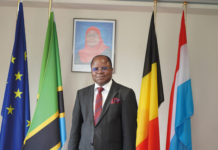Tanzania is one of the best performing economies of Africa. The country enjoyed steady growth for the last decade and a 7.0%[1] GDP increase in 2016. Neighbour to 6 countries, it performs strongly in the industry, construction, services, information and communications sectors.
For an investor, international business or businessman, it is reassuring to know that all the macro-economic figures are encouraging and stable, as is the political landscape, paving the way for businesses to flourish. Inflation remains low, at around 5.2%, and the fiscal deficit is the lowest in seven years, representing 3% of GDP, with the lending rate of the Bank of Tanzania being at 9% to boost growth.
Its stability and interesting economic growth are far from being the country’s only strengths. It is strategically positioned as a gateway to six land locked countries[2]. Its 35 million people belong to the EAC Common Market and the SADC Free Trade Area, expanding its consumer market to over 300 million people.
Thanks to developed rail and road networks, Tanzania is a natural gateway for East and Central Africa. The country has 3 deep water ports (Dar es Salaam, Tanga and Mtwara) servicing the neighbouring countries. Its good international relations and interesting quota and duty-free entry to the markets of the US, Canada, Japan, South Korea and China also represent a major stronghold.
Ranked 137th on the Ease of Doing Business Report, it is ahead of the regional average but still fairly distanced from a country like Kenya, ranking 80th. The country has committed itself in its second Five Year Development Plan 2016/2017 to 2020/2021 and includes keeping fiscal debt low, as well as encouraging Public Private Partnerships and industrialisation.
Tanzania has a negative trade balance[3], importing more than it exports. Therefore, industrialization has been set as a major priority in the Five-Year Development Plan. Its major exports are agricultural products such as tobacco, coffee, cotton – 2nd producer in the world, cashew nuts, tea and cloves. Mineral exportation, gold, diamonds and tanzanite are very important and destined for exportation. The country’s main export partners are India, Japan, China, the United Arab Emirates, the Netherlands and Germany. Tanzania is ranked 71st for Belgian export.
Transport equipment, machinery, construction materials, oil, fertilizers, industrial raw material and consumer goods are the main imports of Tanzania. These come from China, India, South Africa, Kenya and the United Arab Emirates.
Tanzania aims to become an industrialized middle-income country by 2025. In order to get there, a specific roadmap has been foreseen in the Five-Year Development Plan, putting a greater accent on building a strong industrial base. To this end, Tanzania has set up Export Processing Zones (EPZs) and Special Economic Zones (SEZs) as ponds of industrial growth and services to promote export trade. The EPZ scheme promotes investment in the manufacturing sector mainly for export, while the SEZ scheme involves other sectors such as agriculture, trade, tourism, mining, and forestry. An investor might opt to invest in, but not limited to, the following sectors:
- Agriculture and agricultural products.
- Metal products, machinery and transport equipment.
- Electronics and electric appliances
- Chemicals, paper and plastics.
- Light industries.
- Mining, ceramics and gemstones.
Tanzania offers generous fiscal incentives under the Export Processing Zone/Special Economic Zone (EPZ/SEZ) schemes to attract Foreign Direct Investments (FDIs) and Domestic Direct Investments (DDIs)[4].
Any investor can qualify to invest under the Special Economic Zone Scheme provided they meet these simple criteria:
- The investment must be new.
- Annual export turnover should not be less than US$ 5 million for foreign investors and US$ 1 million for local investors.
iii. Adequate environmental protection systems.
- Use of modern production processes and new machinery.
- Investments must only be located in SEZ industrial parks.
Agriculture, the backbone of the economy
As you may infer from our key figures, the Tanzanian economy and its GDP still largely rely on agriculture – accounting for 85% of all exports, and 80% of the workforce. There are over 44 million hectares of arable land available in Tanzania, with 29.4 million ha suitable for irrigation. Agriculture has a huge role to play in the country’s industrialisation, offering the possibility of providing markets for industrial products and raw materials for industries. Investment opportunities in agriculture include:
- Undertaking in large-scale commercial farming of crops such as sugarcane, rice, wheat, coffee, tea, sunflower, pulses, floriculture, cotton, sisal, grape, simsim and maize.
- Huge potential for sugarcane farming and sugar production. Sugarcane farming and sugar production are supported by vast water sources, good climate conditions and huge market potential
- Huge potential in investment in agro-industries and agro-processing
- Development of outgrowers to complement the sources of raw materials for the industries as appropriate
- Expansion and improvement of irrigation systems; improvement of R&D in crops cultivation
The mining sector has grown very rapidly in recent years. In 2017 alone, it grew by 8.5 percent, exporting minerals such as gold, Tanzanite gemstones to other geographic regions. Investment opportunities include:
- Processing of precious metals and gemstones.
- Establishing a caustic soda refinery plant in Engaruka
- Production of iron ore and steel in Liganga;
- Processing of nickel in Kabanga; and
- Extracting Uranium in Mkuju.
- Investment in minerals smelters
The discoveries of large natural gas reserves on the coastal shore of the Indian Ocean at Songosongo, Mnazi bay and Mkuranga in Coast Region have spurred natural gas developments in Tanzania. Currently there are 22 oil companies undertaking exploration activities for oil and gas in the country. These companies include: BG Group, Statoil, Petrobas and Ophir Energy. Tanzania is becoming a regional hub after a flurry of discoveries. It is said to be blessed with over 41.7 trillion cubic feet of gas reserves, according to recent estimates. The potential is huge as the exploration and extraction of the gas reserves are still in its early stages. Investors have the following opportunities:
- Domestic production and marketing of liquefied natural gas (LPG).
- Domestic manufacturing of LPG cylinders, valves and regulators, installation of filling plants, retail distribution and development of simple, flexible and less expensive gas burners to encourage the use of gas instead of wood.
- Establishment of processing plants and industries for the production of refined mineral oil, petroleum jelly and grease, fertilizers; bitumen-based water/damp-proof building materials, e.g. roofing sheets, floor tiles and tarpaulin
- Establishment of chemical industries, e.g. distillation units for the production of Naphtha and other special boiling point solvents used in food processing.
- Development of petrochemical industries.
- Establishment of LNG projects.
- Small-scale production of chemicals and solvents e.g. chlorinated methane, formaldehyde, acetylene etc. from natural gas.
- Crude oil refining with efficient export facilities.
Tanzania’s tourism industry accounts for about 24.0% of its exports and 17.2% of GDP. This is a fast-growing sector that offers plenty of investment opportunities. Here are some of the opportunities waiting to be seized by entrepreneurs:
- Construction of tourist hotels in towns, game parks as well as along the 850-mile coast line of mainland Tanzania and the beautiful shores of the spice Island of Zanzibar
- Establishment of leisure parks.
- Construction of golf courses.
- Investing in conference tourism facilities.
- Provision of air/ground transport.
- Tour operations and trophy hunting.
- Sea and lake cruising.
- Development of eco-tourism facilities.
- Beach tourism, cultural and historical sites
Tanzania offers abundant natural resources which provide for plenty of raw materials for the manufacturing industries such as cotton for the garment and textile industries, sisal for canvassing, iron for steel, as well as various minerals and gemstones. There are opportunities for establishing SEZs/EPZs. As it is totally dependent on the import of passenger cars and has a large deficit due to the import of refined sugar and edible oil, there are many opportunities in this field.
In the manufacturing sector, Tanzania offers opportunities for
- The establishment of SEZs/EPZs, industrial parks and logistics centres,
- Establishing motor vehicle and motorcycle assembly plants and spare parts production facilities for domestic and regional markets.
- Construction, rehabilitation and providing requisite support to strategic pharmaceutical industries.
- Production of construction materials, development of iron and steel industries.
- Agro-industries and agro-processing to add value to agricultural, livestock, forestry and fisheries products.
- Sugar industry.
- Increasing domestic edible oil production.
- Food and beverages: processing, and preservation of meat, fish, fruit, vegetables, oils and fats.
- Manufacture of dairy & other food products
- The manufacture of bottled and canned soft drinks, fruit juices, beer, and wines.
Tanzania is identified as one of the 20 countries that will in the near future offer the most opportunities for consumer goods companies globally, particularly for food and beverages
Services
There are enormous opportunities in the services sector, particularly ICT. The market has changed rapidly over the last ten years and has increased number of subscribers, the variety of services offered, and has seen the coverage area expand.
- Provision of mobile services especially in rural area as penetration is higher in urban areas.
- Provision and operation of value added network/data services (internet, voice mail, electronic mail services).
- Repair and maintenance of telecommunications facilities
- Huge potential in financial services which include establishment of financial institutions, microfinance banks, investment banks, agricultural banks and commercial banks.
There were approximately 39,808,4196 mobile subscribers in the market in December 2015, compared to 2,963,737 in 2005. The 2017 GDP growth rate has pushed the number of mobile phone owners up even higher. Penetration stood at 67% in December 2014, against 10% in 2005. The number of internet service subscribers has increased from 3.5 million users in 2005 to 16 million in 2015.
Energy
At present, 21% of the population with about 7.4 percent in the rural areas has access to electricity. Tanzania is endowed with diverse energy sources, including biomass, natural gas, hydro, coal, geothermal, solar and wind power and uranium, much of which is untapped. Commercial energy sources, i.e. petroleum and electricity, account for about 8% and 1.2%, respectively, of the primary energy used. Coal, solar and wind account for less than 1%.
The Tanzania power sector is dominated by a single vertically integrated national utility, Tanzania Electricity Supply Company Ltd (TANESCO). The total plant generation capacity of public and private power plants is 1,438.24 MW. There are many opportunities in this sector, including:
- Generation, transportation and distribution of energy from various sources
- Power infrastructure development, rehabilitation and expansion
- Extraction of biofuels – ethanol from sugar; biodiesel from palm oil and jatropha
- Construction of a petroleum pipeline and petroleum products offloading terminals, development of upcountry storage and distribution facilities
- Geothermal exploration and development
- Rural electrification
- Development of new and renewable energy resources, and
- Promotion of energy efficiency and conservation initiatives
Economic infrastructure
Improving the transportation infrastructure is a key priority for the government of Tanzania. Developing the nation’s roads, ports, railways and airport infrastructure is critical to the country improving its internal and external trade and commercial activities. The sector’s further development includes improvements in the energy sector as Tanzania strives to become a middle-income country.
- Infrastructure projects provide exciting opportunities for investors looking to capitalise on Tanzania’s fast growing economy.
- Large road construction works as well as PPP opportunities in airport, rail and port projects,
- Huge untapped opportunities in the power generation sector, utilizing the country’s abundant energy resources such as natural gas, coal, uranium and renewable resources
- Opportunities in the development of inland container depots and extended railway lines.
Real Estate
Accommodation in Dar es Salaam and other cosmopolitan areas is in acute shortage due to, among other reasons, the rapid growth of economic projects, which has attracted vast numbers of people (international and local) needing housing. It is projected that half of Tanzania’s 45 million inhabitants will have moved to urban centres over the next 20 years, more has to be done in terms of offering more housing loans and constructing homes to meet the ever-growing housing needs.
Investors may form a synergy with the National Housing Corporation (NHC) or the Tanzania Building Agency (TBA), or other private firms and provide commercial building solutions for residential and commercial purposes.
Fisheries
Tanzania is one of the largest fishing nations in Africa. It is ranked in the top 10 countries in terms of total capture fisheries production, according to the FAO. Annual fish production averages 341,065 tons and accounts for 1.4% of GDP and 10% of national foreign exchange earnings. With an impressive coastline, close to 1,400 square kilometres, 3 major inland lakes, Lake Victoria, Tanganyika and Nyasa, its freshwater covers an astonishing 6.1% of its total territory. Total employment comprises 177,527 fishermen and 4 million people in down flow industries. The possibilities for investors include:
- Establishment of fishing port and fishing in the Exclusive Economic Zone[5],
- Establishing fish processing plants and modern fishing boat building yards.
- Establishment of dry docking and eco-tourism facilities.
- Around 3,000 hectares suitable for shrimp farming in Mafia Island.
- Establishment of commercial fish cage culture in both marine and freshwater areas
- Cultured species, including: Mud crabs, oysters, grouper and scallops for mariculture
- Freshwater species, including: tilapias, African catfish, rainbow trout and freshwater prawns
- Production of formulated fish feeds and live fish food (e.g. earthworms)
- Deep sea fishing, fish processing, …
Livestock
Tanzania has outstanding natural resources for livestock development, including resilient livestock breeds, extensive rangelands and diverse natural vegetation of 88.6 million hectares of land resources in the country, with 60 million hectares deemed suitable for grazing. As its population is increasing, demand for livestock is expected to increase threefold by 2030. Thanks to its geographical location and connectivity to the continent, it may very well be the next major player in the livestock market. Opportunities include:
- Establishment of joint venture projects with the National Ranching Company and other privately owned ranches to modernise existing ranches,
- Establishment of new ranches (cattle, sheep and goats) and farms (poultry and piggery),
- Livestock fattening, slaughtering facilities, processing plants, breeders farm, animal feeds processing plants, commercial layer and broiler farms, broiler processing plants, act as market for SME poultry production, tanneries, footwear and leather goods, dairy farms, livestock farming investment on beef, dairy, chicken, hides and skins.
Banking
The banking sector in Tanzania has been booming, growing in assets and in profits. Because of this, new merchant banks, commercial banks, exchange offices, insurance companies, a stock exchange and related financial units have entered the market. There are four types of banks, all catering to different markets and clientele operating in Tanzania: local private banks, regional banks, international banks and multinational banks.
The market is open to the establishment of fully-fledged commercial banks, the development of financial institutions, community banks, microfinance banks or financial leasing companies.
Telecommunications
The TCRA has also approved a Converged Licensing Framework (CLF), which allows operators to offer any type of service with the technology of their choice using a single licence. The licences are technology-neutral and service-neutral.
As a result of such convergence in licensing, Tanzania’s telecommunications sector has become more appealing to both Foreign Direct Investment (FDI) and domestic capital, and is becoming one of the country’s fastest growing sectors.
Communication is growing at a rate of 20% annually due to the increase in mobile phone activities, and market penetration is now 61%. Tanzania is now connected via fibre-optic cable to global networks throughout India and Europe. This development has led to increased investment by internet service providers (ISP).
- Provision and operation of private network links employing cables, radio communications, or satellite, within Tanzania.
- Provision and operation of public mobile communications (cellular mobile telephony, paging, and trunked radio)
- Provision and operation of community telecommunications (rural and urban)
- Provision and operation of value added network/data services (internet, voice mail, electronic mail services)
- Sales and installation of terminal equipment.
- Repair and maintenance of telecommunications facilities, and
- Cabling (e.g. telephone-external and internal wiring for residential, office etc.).
More Information
Official website www.tanzania.go.tz
The Business Registrations and Licensing Agency (Brela) www.brela-tz.org
National Bureau of Statistics (NBS) www.nbs.go.tz
Tanzania Investment Centre (TIC) www.tic.co.tz
Tanzania Revenue Authority (TRA) www.tra.go.tz
[1] World Bank
[2] Uganda, DRC, Rwanda, Burundi, Zambia and Malawi
[3] USD 608.20 Mo of exports, USD 741.00 Mo of imports, deficit of USD 132.80 Mo – May 2017 – source: Bank of Tanzania
[4] Please visit http://www.epza.go.tz/index.php
[5] The Special Economic Zone covers an area of 223,000 sq. km
![[:en]TANZANIA_5[:]](https://perspectives-cblacp.eu/wp-content/uploads/2018/04/TANZANIA_5-696x522.jpg)


